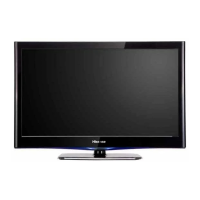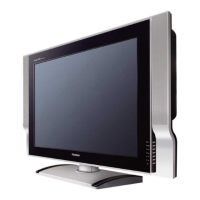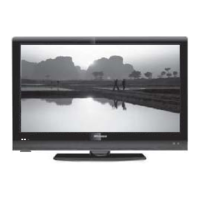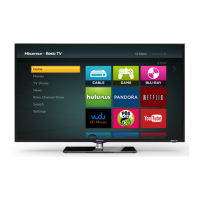How to resolve double images on Hisense LTDN39V77MH?
- BBrad NavarroSep 12, 2025
If your Hisense LCD TV shows double images, consider using a highly directional outdoor antenna or cable TV.

How to resolve double images on Hisense LTDN39V77MH?
If your Hisense LCD TV shows double images, consider using a highly directional outdoor antenna or cable TV.
Safety tips for TV placement and usage to prevent injury.
Guidelines for safely mounting the TV on a wall.
A comprehensive list of safety instructions for operating the TV.
Details on electrical shock, lightning, power lines, and LCD panel handling hazards.
Important warnings and advice before installing or removing the TV stand.
Lists the items that should be included in the TV box.
Step-by-step guide for attaching the TV to its stand.
Step-by-step guide for detaching the TV stand.
Identifies and describes physical buttons on the TV.
Instructions for attaching the TV to a wall-mount bracket.
Guidelines for securing the TV to a desk to prevent tipping.
Steps to detach the TV stand from the unit.
Details the various input/output ports on the back of the TV.
Explains the buttons and functions of the TV remote control.
Instructions for inserting batteries into the remote control.
Guidance on pointing the remote towards the TV sensor.
Steps to connect the TV to a power outlet.
Advice on choosing an optimal place to position the TV.
How to connect devices using an HDMI cable for high-quality output.
Steps to connect devices using component video cables.
How to connect TV to broadcast sources via antenna or cable.
Steps for connecting older AV devices like VCRs or game consoles.
Instructions for connecting a computer to the TV for display.
How to connect home theater systems and headphones.
How to connect USB storage devices to the TV.
Instructions for turning the TV on, off, and into standby mode.
How to switch between different connected devices.
How to view current program details and signal information.
Guide to using the TV's menu system for settings.
Options for customizing picture quality like mode, contrast, brightness.
Options for customizing audio output like mode, equalizer, balance.
Settings for closed captions, sleep timers, and V-Chip parental controls.
Configuration options for language, channels, and system time.
Settings for optimizing display when connected to a PC.
Controls for slideshows, transitions, and zoom for media playback.
Explains Vivid, Standard, Game, Cinema, and Power Saver picture modes.
How to change the display format (e.g., 4:3, 16:9, Zoom).
Explains sound modes like Standard, Music, Clear Voice, and Custom.
How to fine-tune audio frequency and speaker balance.
Settings for closed captions, sleep time, and V-Chip.
Information on U.S. and Canadian age-based and content-based TV ratings.
Options for language, channel scanning, and system time setup.
Instructions for channel scanning and managing available channels.
Solutions for common issues like no picture, poor picture, or no sound.
Troubleshooting steps if the remote control is unresponsive.
Solutions for issues like missing channels, lost passwords, or cabinet noises.
Guidelines for safely cleaning the TV case and LCD screen.
Details on TV type, panel, system, power, and dimensions.
FCC and IC compliance statements, and cable connection advice.
Steps to enter the hotel settings menu using a password.
Enabling/disabling hotel features and setting initial TV options.
Locking specific TV functions like keypad, picture, and audio adjustments.
Locking feature, installation, DMP, V-Chip, and input selections.
Adjusting maximum/minimum volume and auto standby behavior.
Accessing channel settings and editing channel lists.
Methods for copying settings to multiple TVs using a USB drive.











